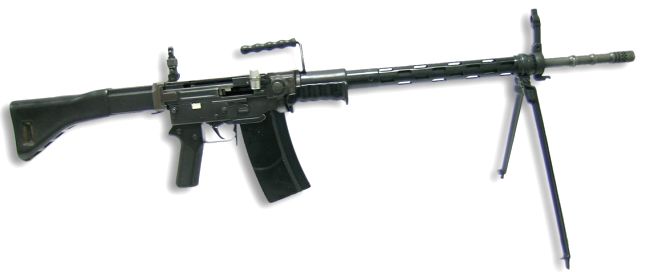Action: roller retarded blowback
Overalllength: 1105 mm (1016 mm SIG 510-4)
Barrel length: 583 mm (505 mm SIG 510-4)
Weigth: 5.56 kg empty (4.25 rg empty SIG 510-4)
Magazine capacity: 24 rds (20 rds SIG 510-4)
Switzerland began to experiment with intermediate cartridges before the
World War 2 and, being a neutralcountry, closely watched the
developments made during and after the war. Being entirely satisfied
with the power and accuracy of its 7.5 mmGP11 (7.5x55) cartridge, the
Swiss army tried to achieve a full power selective-fire rifle. After a
couple of false starts, first with the gas-operated Sk-46 self-loading
rifle, and secondly with the most unusual AK-53 blow-forward design, the
famous SIG company finally produced a weapon which satisfied the Army
in 1955.
This was the 7.5 mm AM-55, a retarded blowback design, developed under the leadership of the Rudolf Amsler. The basic principles of the action were borrowed from German WW2 period Mauser 'Gerät 06H' and Stg.45(M)assault rifles, but with much altering involved. In 1957 the Swiss army adopted the AM-55 as the Schturmgewehr-57, or Stgw.57 for short. Madebetween 1957 and 1983, the Stgw.57 represented one of the finest and most expensive automatic rifles ever issued to any army in the world.Chambered for full power 7.5 x 55 GP11 ammunition, the Stgw.57 provides long range accurate shooting in semi-automatic mode, necessary for thetypical Swiss mountain country, in combination with significant fullauto firepower, thanks to its relatively heavy weight, integral bipodand a shrouded barrel. In the modified form, known as the SIG-510, this design was relatively successful, being sold to various South Americancountries, most notably Bolivia and Chile, chambered for 7.62 mm NATO ammunition.
This was the 7.5 mm AM-55, a retarded blowback design, developed under the leadership of the Rudolf Amsler. The basic principles of the action were borrowed from German WW2 period Mauser 'Gerät 06H' and Stg.45(M)assault rifles, but with much altering involved. In 1957 the Swiss army adopted the AM-55 as the Schturmgewehr-57, or Stgw.57 for short. Madebetween 1957 and 1983, the Stgw.57 represented one of the finest and most expensive automatic rifles ever issued to any army in the world.Chambered for full power 7.5 x 55 GP11 ammunition, the Stgw.57 provides long range accurate shooting in semi-automatic mode, necessary for thetypical Swiss mountain country, in combination with significant fullauto firepower, thanks to its relatively heavy weight, integral bipodand a shrouded barrel. In the modified form, known as the SIG-510, this design was relatively successful, being sold to various South Americancountries, most notably Bolivia and Chile, chambered for 7.62 mm NATO ammunition.
The action of the Stgw.57 was derived from the roller-retarded blowback
system originated by Mauser engineers in Hitler’s’ Germany. However,
the Swiss designers replaced the roller swith the roller-shaped pivoting
flaps, interposed between the bolt head and the bolt body. The receiver
is made from stamped steel, with a separate trigger unit housing made
integral with the pistol grip frame and trigger guard. The fixed barrel
has a perforated steel jacket with two mounting points for an integral
bipod – one near the muzzle, and another near the receiver. The front
part of the barrel is exposed to act as a rifle grenade launcher. To
smooth out the excessive recoilgenerated in full automatic fire, and
especially by rifle grenades, thefixed butt-stock is fitted with a
recoil buffer. The safety / fire mode selector is located at the left
side of the trigger unit. Stgw.57 isfitted with large, T-shaped charging
handle and with the folding“winter trigger”, which, when unfolded,
extends down below the triggerguard, enabling the rifle to be used in
arctic mittens. Since theStgw.57 was designed with the so-called
straight-line layout, theraised sights are mounted on high, folding
bases, with the rear sight being micrometer-adjustable from 100 to 650
metres. The Stgw.57 also could be fitted with the special Kern 4X
telescope sight. Stgw.57 is fed from curved box magazines, made from
steel and containing 24rounds. The small forend is made from plastic and
the gun is fitted with a side-folding carrying handle. Other
accessories include the sling, the bayonet, and a special small-capacity
magazine for blankgrenade-launching cartridges.
Export military versions of the Stgw.57, known as SIG SG-510, were made in 4 basic modifications, of which only one was made in any significant quantities, the SG-510-4.This was chambered in 7.62 x 51 NATO, had a shorter barrel, and non-folding aperture sights. The forend and buttstock were made from wood.
Other versions included the SG-510-1 (exactly the samerifle as the Stgw.57), the SG-510-2 (a lightweight modification of theStgw.57, also in 7.5 mm), and the more compact SG-510-3, chambered forthe Soviet 7.62 x 39 cartridge (produced in late 1950s for assault rifle trials in Finland). Civilian semi-automatic only versions of the Stgw.57 were designated as PE-57 (in 7.5 mm GP11) and SIG AMT (a semi-auto version of SG-510-4 in 7.62 mm NATO).
Export military versions of the Stgw.57, known as SIG SG-510, were made in 4 basic modifications, of which only one was made in any significant quantities, the SG-510-4.This was chambered in 7.62 x 51 NATO, had a shorter barrel, and non-folding aperture sights. The forend and buttstock were made from wood.
Other versions included the SG-510-1 (exactly the samerifle as the Stgw.57), the SG-510-2 (a lightweight modification of theStgw.57, also in 7.5 mm), and the more compact SG-510-3, chambered forthe Soviet 7.62 x 39 cartridge (produced in late 1950s for assault rifle trials in Finland). Civilian semi-automatic only versions of the Stgw.57 were designated as PE-57 (in 7.5 mm GP11) and SIG AMT (a semi-auto version of SG-510-4 in 7.62 mm NATO).
By: world.guns.ru

No comments:
Post a Comment